Gombe is a special site for many reasons. Among them: It is the first site where wild chimpanzees were observed to make and use tools. It is also the only wild site where twin chimpanzees have survived to adulthood. On my recent visit to Gombe, I had the good fortune to see the twins and their daughters making and using tools to fish for termites.
Back in 2002, I remember following a large group of chimps in the Kasekela community, on the narrow trail climbing the steep path above Kakombe Valley, heading south to Mkenke Valley. It was Mabungo season and the chimps were feasting on fruits from the different kinds of Mabungo vines, especially Mabungo Makubwa (Big Mabungo) and Mabungo Madogo (Little Mabungo). The chimps traveled single file down the narrow trail. In the midst of the rainy season, everything was lush, green, and wet. The last chimp in the line was Gremlin, carrying her twins, Golden and Glitter, on her back. Sometimes their older sister Gaia would help mom by carrying one of the little twins. Gaia’s help is probably one reason that Golden and Glitter survived to adulthood — the only known pair of wild chimp twins known to have done so. Even with this help, though, the twins slowed Gremlin down. Being new to Gombe, struggling with the hikes up and down the hills, I was quite happy walking behind them, grateful for a chance to rest a little while watching these little girls play.
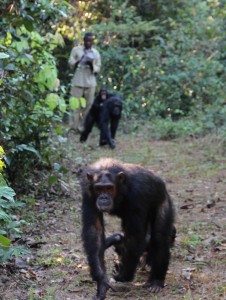
Now Golden and Glitter are all grown up. Female chimpanzees usually leave the group of their birth and join a new one, to avoid mating with their brothers, uncles, fathers and such. At Gombe, though, about half of the Kasekela females stay in their natal group, probably because the dispersal options are limited: Mitumba is small and crowded, while Kalande is big but less forested (so less food) and has too few adult males. So Golden and Glitter have stayed in Kasekela, as did their mother Gremlin.
We don’t know if Gremlin’s mother Melissa was born in Kasekela or if she immigrated from elsewhere. But now that Golden and Glitter have babies of their own (Glamour and Gossamer), we have four generations of G-family girls in one community. Their older sister Gaia has also stayed in Kasekela. When all the G-family moms and babies get together, it’s more like a baboon matriline than a typical chimpanzee group of unrelated females. This concentration of female kin might have some interesting implications for social behavior. Maybe all these related females will gang up on other females to control access to the best home ranges? They do seem very well established in Kakombe Valley, the best, most productive valley in Gombe in terms of chimpanzee foods.
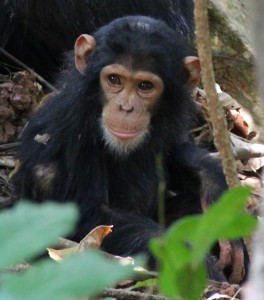
This June, in between visits to the Kalande and Mitumba communities, I was able to spend some time following the twins and their daughters.
They spent much of the morning fishing for termites. Usually there’s more termite fishing in the wet season than this time of year, the early dry season, but perhaps the recent rains had softened up the mounds enough to make it easier for the chimps to stick in their termite fishing tools: wands made of grass or sticks, stripped of leaves to make slender probes.
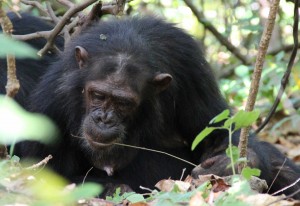
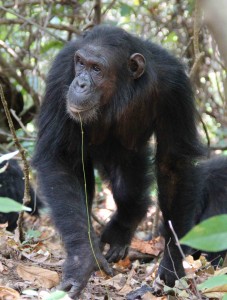
(11 June 2014)
Jane Goodall’s discovery that chimpanzees make and use tools to fish for termites was one of the key findings that made Jane and Gombe famous. In The Descent of Man, Darwin argued that the making and using of tools originated after the evolution of bipedalism: walking on two legs freed the hands for manipulation, rather than transportation. It was therefore a surprising discovery that these knuckle-walking forest apes regularly used their hands, not just for walking and climbing, but also for making and using what has turned out to be a large variety of tools.
Tools increase access to important foods that would not otherwisebe available. Termites, for example, are rich in fat and protein, nutrients that are important but not well supplied by the mainstay of chimpanzee diet, ripe fruit.
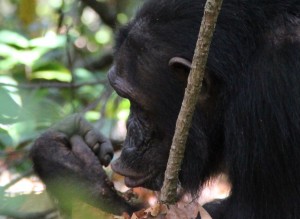
(11 June 2014)
Tool use also increases the value of social learning. Termite fishing is a skill that takes years to learn properly, and kids mainly learn how to termite fish from watching their moms. As Elizabeth Lonsdorf elegantly showed with her studies of termite fishing at Gombe (in which Gremlin and the twins figured prominently), girls learn to termite fish faster than boys, probably because boys are too busy playing rough-and-tumble games.
Once cultural learning is established, a whole range of new subsistence strategies can be acquired that any one individual would never think to invent on their own.
Darwin was probably right that being bipedal helps with making and using tools. Chimpanzee hands are long, with curved fingers and short, weak thumbs. Australopith hands are much better suited for both the precision grip and the power grip. They must have had a much broader range of tools than chimpanzees: sticks for digging food and hitting rivals, stones for smashing food and throwing at enemies. But the discovery of tool use and material culture in chimpanzees suggests that these practices may have already been present in our common ancestor with chimpanzees, predating the origin of bipedalism — and perhaps providing increased selective advantages for individuals in those populations that first started standing bipedally a bit more than usual.
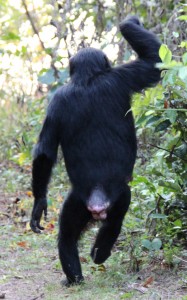
(10 June 2014)
